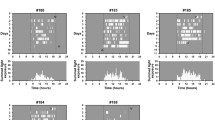Summary
The circadian rhythm of a tropical insectivorous bat,Taphozous melanopogon, free-runs in dim light and responds to dark breaks of a few hours' duration with ‘advances’ and ‘delays’ as a function of the phase experiencing the “black out”. Similarly phase shifts also follow perturbations by light breaks. The time course and the wave form of the phase response curves obtained from experiments using pulsed light and pulsed darkness are mirror images of each other.
Similar content being viewed by others
Abbreviations
- L:
-
light
- D:
-
darkness
- L/D:
-
light/darkness cycles
- LL:
-
continuous light
- DD:
-
continuous darkness
- PRC:
-
phase response curve
- τ :
-
period length
References
Aschoff, J.: Response curves in circadian periodicity. In: Circadian clocks (ed. J. Aschoff), pp. 95–112. Amsterdam: North-Holland 1965
Bünning, E.: The physiological clock, pp. 258 (revised 3rd English Ed.). Berlin-Heidelberg-New York: Springer 1973
Bünning, E., Moser, I.: Influence of valinomycin on circadian leaf movement ofPhaseolus. Proc. Natl. Acad. Sci. USA69, 2732–2733 (1972)
Chandrashekaran, M.K.: Phase shifts in theDrosophila pseudoobscura eircadian rhythm evoked by temperature pulses of varying durations. J. Interdiscipl. Cycle Res.5, 371–380 (1974)
Chandrashekaran, M.K., Loher, W.: The effect of light intensity on the circadian rhythm of eclosion inDrosophila pseudoobscura. Z. vergl. Physiol.62, 337–347 (1969)
DeCoursey, P.J.: Effect of light on the circadian activity rhythm of the flying squirrelGlaucomys volans. Z. vergl. Physiol.44, 331–354 (1961)
Engelmann, W.: Effect of light and dark pulses on the emergence rhythm ofDrosophila pseudoobscura. Experientia22, 606 (1966)
Engelmann, W., Honegger, H.-W.: Versuche zur Phasenverschiebung endogener Rhythmen: Blütenblattbewegung vonKalanchoe blossfeldiana. Z. Naturforsch.22, 200–204 (1967)
Huffman, K.: Overt circadian frequencies and circadian rule. In: Circadian clocks (ed. J. Aschoff), pp. 87–95. Amsterdam: North-Holland 1965
Pittendrigh, C.S.: The circadian oscillation inDrosophila pseudoobscura pupae: a model for the photoperiodic clock. Z. Pflanzenphysiol.54, 275–307 (1966)
Pittendrigh, C.S., Daan, S.: A functional analysis of circadian pacemakers in nocturnal rodents. II. The variability of phase response curves. J. comp. Physiol.106, 253–266 (1976)
Pittendrigh, C.S., Minis, D.H.: The entrainment of circadian oscillations by light and their role as photoperiodic clocks. Am. Naturalist98, 261–294 (1964)
Subbaraj, R., Chandrashekaran, M.K.: ‘Rigid’ internal timing in the circadian rhythm of flight activity in a tropical bat. Oecologia (Berl.)29, 341–348 (1977)
Takimoto, A., Hamner, K.C.: Studies on red light interruption in relation to timing mechanisms involved in the photoperiodic response ofPharbitis nil. Plant Physiol.40, 852–854 (1965)
Wilkins, M.B.: The effect of light upon plant rhythms. Cold. Spring Harbor Symp. Quant. Biol.25, 115–131 (1960)
Winfree, A.T.: Integrated view of resetting a circadian clock. J. Theor. Biol.28, 327–374 (1970)
Zimmermann, W.F., Pittendrigh, C.S., Pavlidis, T.: Temperature compensation of the circadian oscillation inDrosophila pseudoobscura and its entrainment by temperature cycles. J. Insect Physiol.14, 669–684 (1968)
Author information
Authors and Affiliations
Additional information
Dedicated to Professor Colin S. Pittendrigh on the occasion of his 60th birthday
We thank Professor Dr. E. Bünning and Dr. Wolfgang Engelmann for making critical improvements to the manuscript. We also thank our colleagues in the Unit of Animal Behaviour for their ready and cheerful participation in the several stages and processes that led to the writing of this paper. Financial support by the University Grants Commission, Government of India, in the form of a generous grant and generous donations of equipment for work on chronobiology by the Alexander von Humboldt Foundation, Bonn-Bad Godesberg, both to M.K.C., are gratefully acknowledged.
Rights and permissions
About this article
Cite this article
Subbaraj, R., Chandrashekaran, M.K. Pulses of darkness shift the phase of a circadian rhythm in an insectivorous bat. J. Comp. Physiol. 127, 239–243 (1978). https://doi.org/10.1007/BF01350114
Accepted:
Issue Date:
DOI: https://doi.org/10.1007/BF01350114



